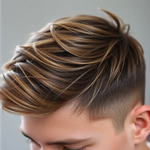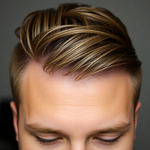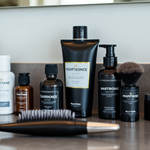
Swap Your Shade, Not Your Closet: A Practical Playbook for Using Semi-Permanent Hair Color with a Men's Capsule Wardrobe
27 September 2025
Share
Intro — Quick Hook
Semi-permanent hair color is one of the quickest, most versatile ways to change your look without touching your capsule wardrobe. If you want a fresher, sharper presence for work, dates, or weekend hangs—without buying a single new piece—this is the playbook. Read on for a full, practical guide that walks you through choosing a shade, applying it safely, maintaining color, and using your new hair tone to maximize the versatility of a men's capsule wardrobe.
Why Semi-Permanent Hair Color Works for Capsule Wardrobes
Simplicity is the ethic of the capsule wardrobe—and semi-permanent hair color follows the same rule. It lets you toggle your visual signature while keeping the clothing set small, intentional, and interchangeable. Unlike permanent dye, semi-permanent formulas deposit color on the hair surface and fade over time, so you can experiment with tone, correct early gray, or subtly deepen your natural shade without long-term commitment or heavy chemical damage.
Benefits at a Glance
- Low commitment: Fades predictably over 4–8 washes.
- Minimal damage: Typically ammonia-free and gentler than permanent color.
- High impact: A small change in hair tone can refresh facial contrast and outfit cohesion.
- Cost-effective: An at-home kit or salon touch-up costs far less than a wardrobe overhaul.
Semi-Permanent Hair Color: How It Fits Into a Men's Capsule Wardrobe
Integrating semi-permanent hair color into your capsule strategy is about intentional pairing. Think of hair as an additional capsule item: one variable that adjusts the entire look of your clothes. Choose a consistent hair tone that complements the majority of your pieces—this reduces decision fatigue and helps you build a recognizable personal style.
Start Here: Audit Your Capsule
Before coloring, know the foundation you’re pairing with. Run this quick audit:
- Identify dominant colors: Navy, charcoal, black, earth tones, olive, tan? Mark the three most common shades.
- Assess finishes and textures: Matte wool, cotton, leather—different textures interact with hair tone differently.
- Determine your style goal: Are you going for polished/professional, rugged/approachable, or modern/minimalist?
Choosing the Right Shade
Match hair tone to capsule palette and skin undertone for best results. Here’s a practical guide:
- Cool palettes (navy, charcoal, black): Cooler hair tones (soft black, dark ash brown) or slightly warmer tones for contrast. Avoid overly warm copper that clashes with navy.
- Warm palettes (tan, olive, brown): Warm chestnut, golden brown, or rich mocha shades enhance harmony.
- Mixed palettes: Opt for a neutral shade—medium brown with slight ash or golden undertone depending on your skin.
Skin Tone Cheat Sheet
- Cool undertone: Choose ash or neutral shades (ashy brown, soft black).
- Warm undertone: Choose warm, golden shades (chestnut, warm brown).
- Olive or neutral: Most mid-range browns work; use contrast level (lighter or darker than your natural) to shift style.
Want to Cover Gray?
Semi-permanent formulas can soften or mask early gray, especially when you opt for a shade close to your natural color. For thicker or heavy gray, a longer-lasting demi or permanent formula might be necessary—but semi-permanent is a low-risk place to start.
Step-by-Step: At-Home Application (Detailed)
Set aside 45–60 minutes for your first at-home application. Here’s an expanded, practical walkthrough.
- Patch test and strand test: 48 hours before the full application, do a skin patch test and a strand test to check color payoff and sensitivity.
- Gather supplies: Semi-permanent dye kit, old towel or cape, gloves, wide-tooth comb, clips, color-safe shampoo and conditioner, timer, and a portable mirror.
- Prep hair: Hair should be clean but not freshly conditioned—some recommend washing the day before to let natural oils protect the scalp.
- Mix and apply: Follow kit instructions. Work in sections from back to front, saturating roots and mid-lengths. For blending gray or enhancing texture, focus on roots and areas with lighter growth.
- Timing: Standard processing is 10–30 minutes. For subtle tone, lean shorter. Keep an eye on the strand test time as your guide.
- Rinse and treat: Rinse until water runs clear, then use the included conditioner or a deep color-safe conditioner to seal cuticle and lock moisture.
- Dry and style: Air-dry or low-heat blow-dry. Evaluate color in natural light before final styling.
Salon vs. At-Home: When to See a Pro
Go to a salon if you:
- Want a dramatic color change or lightening.
- Have a lot of gray requiring precise blending.
- Prefer a lived-in, dimensional result that takes skill to achieve.
At-home is ideal for small shifts, refreshes, and first-time experimentation.
Maintenance Routine — Keep It Simple
To make color last while aligning with a capsule wardrobe’s minimal-care ethos, follow a low-effort maintenance routine:
- Use sulfate-free shampoo: Wash 2–3 times a week when possible to extend color longevity.
- Color-depositing conditioner: Once weekly, use a tinted conditioner to revive tone between applications.
- Cold rinses when possible: Cooler water helps seal the hair cuticle and slow fade.
- Limit heat and chlorinated pools: Protect with a hat or leave-in protectant; re-treat with conditioner after exposure.
Styling and Wardrobe Coordination
Use these styling rules to let your hair color play up the best parts of your capsule pieces.
- Match contrast, not match color: You don’t need exact color matches—focus on keeping contrast consistent. Dark hair pairs well with lighter shirts; warmer tones complement earth-toned jackets.
- Anchor with accessories: A consistent watch, boots, or minimalist sneaker acts as a style anchor. Menll.com’s EcoSneak is a practical pick for everyday wear that matches most capsule aesthetics.
- Trim and facial hair: Keep beards and hairline tidy. A fresh color with unruly facial hair looks less intentional.
Troubleshooting — Common Issues and Fixes
- Too warm/too cool: Use a color-depositing toner or a neutralizing product to balance tone.
- Uneven tone: Apply a color-depositing mask to the lighter areas, or visit a salon for a professional blend.
- Quick fading: Switch to a milder shampoo, reduce washing frequency, and use color-depositing conditioners.
Color Science — A Brief Look
Semi-permanent color coats the hair shaft rather than lifting and depositing pigment deep inside. That’s why it fades with shampooing and why maintenance is gentler. Hair porosity—the degree to which hair absorbs moisture—affects color uptake. Porous hair may take color faster but also lose it quicker; tailor your products accordingly.
Sustainability and Low-Waste Styling
If your capsule philosophy includes sustainability, opt for brands and products with recyclable packaging, low-toxicity formulas, and responsibly sourced ingredients. Menll.com’s grooming collection highlights sustainable choices for the low-waste dresser—pair those products with your semi-permanent routine to keep impact minimal.
Special Considerations: Facial Hair, Balding, and Gray
- Beard coloring: Use a beard-specific color or dilute a semi-permanent with conditioner. Do a strand test to check texture change.
- Balding or receding hairlines: Semi-permanent color can add contrast and the appearance of fuller density but choose natural shades and subtle tones.
- Heavy gray: For full gray coverage that lasts longer, discuss demi-permanent or permanent options with a stylist—semi-permanent is best for blending rather than complete coverage.
Case Study: Three Real-World Profiles
- Young professional (22–30): Capsule: navy blazer, white shirts, dark jeans. Move: soft black or dark ash brown for modern polish. Impact: sharper facial contrast during presentations.
- Creative freelancer (28–38): Capsule: mixed neutrals, layered textures. Move: mid-brown with warm undertones to read approachable and creative. Impact: Balanced with casual blazers and boots.
- Budget-conscious guy (18–45): Capsule: basic tees, denim, one coat. Move: subtle chestnut touch to warm skin tone. Impact: Feels refreshed without breaking the bank.
Expanded FAQ
- How often can I redo semi-permanent color? Every 2–8 weeks depending on fade and desired intensity.
- Will it stain my skin? Temporary staining can happen—use oil or a stain remover to lift color after rinsing.
- Can I combine with bleaching later? You can, but bleaching after repeated semi-permanent treatments requires care; consult a pro.
External Resources
For safety and allergy guidance, consult WebMD’s overview of hair dye safety: WebMD on hair dye safety.
Internal Resources
Looking for grooming essentials that pair with this approach? Browse Menll.com's grooming collection for color-safe shampoos and conditioners: Menll.com Grooming. If you want outerwear that plays well with a new hair tone, check Menll.com's outerwear: Menll.com Outerwear.
Final Notes — Practical Timeline and Costs
Plan your first try as a short project: patch test 48 hours ahead, application day (45–60 minutes), then one week of monitoring (less washing to preserve tone). At-home kits range $15–$45; salon touch-ups run higher but may deliver more natural dimension. Factor in conditioner and color-depositing products as ongoing low-cost maintenance.
Wrap-Up and Single CTA
Semi-permanent hair color is a simple, cost-effective lever to refresh your image without expanding your closet. It pairs perfectly with a men's capsule wardrobe—one shade can change the mood of dozens of outfits. Which shade are you trying first? Share your plan in the comments or browse Menll.com’s grooming collection to find color-safe products and get started.
Vorheriger Beitrag

Semi‑Permanent Hair Dye: The Outfit Multiplier for a Minimal Men's Capsule Wardrobe
Aktualisiert am 28 September 2025
Nächster Beitrag

Closet-Audit Hack: Use Semi-Permanent Hair Color to Stop Overbuying and Perfect Your Men's Capsule Wardrobe
Aktualisiert am 26 September 2025





